The Camellia Club of Mobile
Club History
Meeting Schedule 2011-2012
Regional Events
Resources
Where to Buy the Best Camellias
Newsletters
Camellia Culture
Join Us
Links
Air Layering
Air layering is based upon the centuries-old propagating process developed by the Chinese of layering (rooting) plants. It is a simple process that can be completed in one season. The rooting medium is in the air rather than in the ground. It is a good method of reproducing good-sized plants in one year.
It may be done at any time of the year, but the best time is in the spring when the plants are actively growing. At this time the bark is slipping and easily removed. This is done by removing or roughing the bark and placing sections of branches that are still attached to the plant in the ground and covering them with earth.
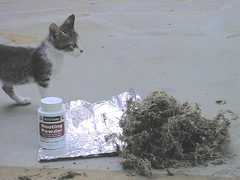 |
You will need rooting hormone, aluminum foil, plastic wrap, sphagnum moss, and a sharp knife. Kitty helper is optional. |
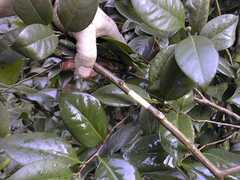 |
On a healthy limb completely remove a ring of bark 1 1/2 to 2 times the diameter of the branch to be air layered. This should be 12 - 24 inches from the tip of the limb. Two parallel cuts may be made with sharp clippers or a knife and the strip lifted off. The branch may be producing new growth, however, the girdled wood must be hardened off. |
 |
Eliminate all traces of the cambium layer (green tissue just inside the bark) by scraping with a knife. If the bark slips off easily, scraping will not be necessary as the cambium layer will be removed with the bark. Dust the exposed surface with a rooting hormone powder recommended for hardwood cuttings or brush on with a paintbrush if it is a liquid solution. |
 |
Cover the ringed area with a handful of presoaked sphagnum moss from which the excess water has been squeezed. |
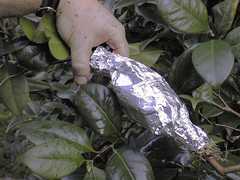 |
Wrap this tightly with aluminum foil (medium weight plastic wrap or other material that will keep moss moist may be used either inside the foil or in place of the foil). Twist ties may be used above and below the ball of moss. The foil may be covered with a black plastic wrap or sprayed with green or beige paint to keep squirrels and birds from damaging the wrap. |
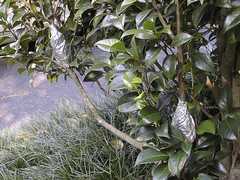 |
Air layers started in the spring have usually formed roots by fall or late summer. Feeder roots will be visible through the plastic. When the roots are visible through the moss, cut the limb from the mother plant at the bottom edge of the moss with sharp clippers. Remove the plastic. Soak in a bucket of water until planting |
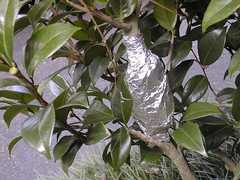 |
DO NOT try to remove the moss as it may damage the tender roots. Best results will usually be obtained by planting first in a container although it can go directly into the ground. Air layers will often flower the first year although excessive buds should be removed so as not to strain the plant. |
Page last modified 08/02/2012